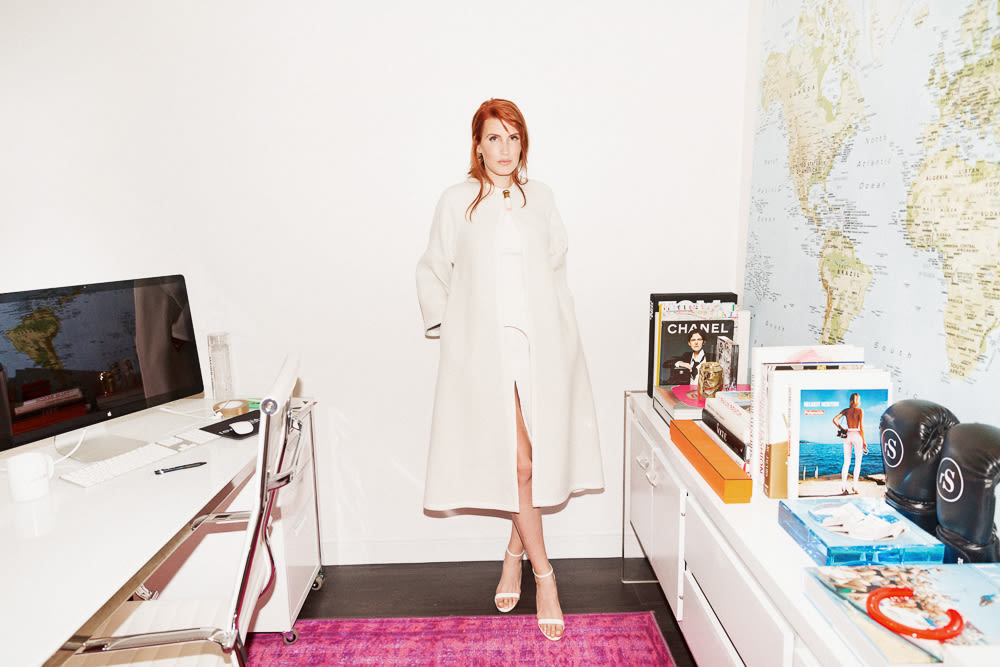'From an early age, I was always making things. In fifth grade, I’d knit scarves in the back row of math class and sell them to people—kind of get them commissioned, I guess. I had a grocery sack that I would keep my hands down in and basically show people what colors I had. I got kicked out of class for that.
By high school I started selling jewelry—legitimately, full-on. This was when Jessica Simpson was big, and she was wearing these wire-wrapped earrings, so I figured out how to make those. I went to a store, got wire, got all the little tools, and made earrings that looked exactly like them. Then my friends started asking, ‘Well, can you make me this pair?’ At the time, I totally didn’t understand economics. I was selling earrings for $20 that probably cost me $18 to make.
I went to Southern Methodist University and got a Corporate Communications Degree and minored in Sociology. I sold jewelry all through college. My style was very avant-garde—it might sound like stuff you’re used to seeing today, but it would be anything from body harnesses to weird beaded crowns or a lot of things with natural stones and vintage pieces. I had a different take on style than the typical Dallas woman and editors always loved it—it actually got a ton of press just on its own for being weird.
At one point, I actually did think that I wanted to be the next Rachel Zoe, so I picked up and drove out to LA and stayed out there for four months to work with different stylists. I quickly realized that styling required schlepping clothes around all day. For every five days of schlepping, there was one day of styling, and you’re working weekends. It wasn’t the lifestyle that I wanted and I quickly checked it off my list.
Then my best friend went to New York for an internship, so I was like, ‘Ok, I’ll try it,’ and I worked for Thakoon on the wholesale side of business, which I liked and was interested in. I learned about being the owner of a store and the elements of that—what makes people tick—and I learned from having my own business and from the styling side of things.
By senior year I met Baxter [Box], who is now my husband, and I showed him all my jewelry. Of course, he was totally uninterested. Then, a few months later, he saw me working on this spreadsheet—which was how I kept track of all my sales—and he was like, ‘You’d make a lot of money doing this. Where’s all this money going?’ His background is in engineering, but at the time he was doing tech investments for a hedge fund, so he was very interested in all of that. I was like, ‘Well, it’s going right back into my clothes,’ because I had my salary from working at a retail store, which was what I lived on, and then I had my jewelry money which, to me, was play money. At that point it was probably double my main salary in the store. He was like, ‘We need to take this seriously, build a website around it, market it.’
I started my blog, Venzedits, about six months into having my jewelry line. I’d left my full-time job at the store and was doing my jewelry, but also really missing styling and sharing with people. Eventually, Baxter mentiond that I was paying a photographer, blogging three times a day, spending more time on it than my jewelry—that I’d basically cut myself out of my own business. He was like, ‘We need to find a solution sooner than later.’ I was living at home with my dad and I desperately wanted to make money. So I went to a fashion blogging conference in New York. I didn’t know any other bloggers at all at the time—I went by myself.
While I was there I met one blogger who was already at the top of her game and well known in New York, and I asked her how she was making money off her blog. She was just like, ‘Well, I get free clothes and I get invited to some events.’ I thought if she didn’t have the answer, probably no one did. So I went back home and we did some research. That’s when the idea for rewardStyle really came about—if you take someone to a store as a personal shopper and they buy something, the store owner pays you commission. That old-school model existed in so many industries and we were looking to make that model digital. We were like ‘This really could be the solution!’
We started working on it and in a few months we had a site built with a few retailers. It was a linking tool—it basically allowed you to search for a product that you wanted to talk about. If a retailer was willing to pay a commission, you could get a link that was trackable. So, for example, when you’re talking about your jeans on your blog, you could search them, see if we had them, and if so, we would track for commission. If not, you would just do what you normally did.
At the time I had no idea about networks, like who they were. I thought that certain bloggers blew up because they were good concepts, but no—it’s because they’re really well-connected and really relatable. I didn’t understand that until a few years after we started rewardStyle. We would work a lot of time off of referrals, or we had someone who’d go and identify top bloggers, and we would reach out to them. It was heavily word-of-mouth. I’d spend an hour or two on the phone with each blogger talking about their business before getting them set up. I remember I never had a voice because I was always just talking.
At first, there were only a handful of retailers that were willing to try it. ‘Content’ was not part of the marketing vernacular yet and no one was really after the blogger group. The first was Shopbop—they’ve always been very digitally savvy and they took a bet that allowed us to have great case studies to show other brands. When we got Net-a-Porter, I was screaming from the rooftops. They were our first true luxury brand that was willing to work with bloggers. It took companies awhile to understand the value of this content, instead of just saying ‘We don’t want to work with girls who think they are journalists, but aren’t.’ That was kind of the opinion at that point. So to have a luxury brand realize the value of what we, as a community, brought to the table…it was a validating moment. We were solving a real problem for people. We have 4,000 brands now—it’s kind of anyone you can think of.
By 2013, we realized that Instagram was the channel that we were publishing to the most—like every two hours. It had the most engagement and the highest follower growth and we had to find a solution that fit gracefully within our platform. So we launched LiketoKnow.it a year ago, which you can use in tandem with everything else. It’s a service that lives in Instagram and is triggered by the ‘like.’ If you’ve sign up for LiketoKnow.it, whenever you 'like' a photo, it will actually trigger an email to your inbox with the photo and all the products referenced in it. People register for the service if they are interested in getting more information, if they like a post and want more about it. So it’s a very targeted audience.
I think that a 360º perspective is so important in any industry. My advice to someone starting out would be to work as soon as you can and to work on all sides of the business, but also to work for the best people in any field. Being our own client is what has made rewardStyle successful. People are like, ‘You took such a big risk!’ And I am like, did I? I was already broke, so it wasn’t that scary starting out. I was already living at home and eating cereal, so…'
—as told to ITG
Amber Venz Box photographed by Tom Newton in Dallas on April 24, 2015.
Want more career advice? We got more career advice, courtesy of casting director Jennifer Starr, makeup artist Yadim, and designer Peter Som.










